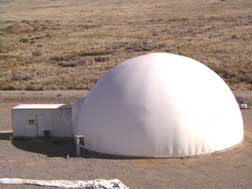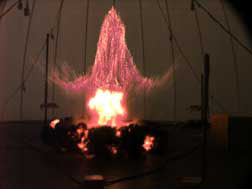
Download 300dpi JPEG image, “rdd-experiments2.jpg,” 496K (Media are welcome to download/publish this image with related news stories.)
ALBUQUERQUE, N.M. and UPTON, NY — If a so-called “dirty bomb” exploded in a populated area, first responders would have to make immediate decisions to lessen health impacts on people who might be exposed to radioactive material. In a cover article in the April issue of the Health Physics journal, Sandia National Laboratories senior scientist Frederick Harper and Brookhaven National Laboratory health physicist Stephen Musolino offer guidance to first responders, planners, and other decision makers for protective actions during the first 48 hours after such a device — formally known as a radiological dispersal device (RDD) — has been detonated.
“By the time it is known that an attack has occurred, most likely there will have been casualties, all the radioactive material will have been released and it will have begun to disperse,” Musolino says. “The goal of this research is to provide science-based response recommendations to the U.S. Department of Homeland Security to consider for use in community preparedness activities.”
Sandia is a National Nuclear Security Administration (NNSA) laboratory.
Over the past two decades, more than 500 explosive experiments were conducted at Sandia to determine how the radioactive material in a RDD would disperse in the environment through aerosolization, which forms a cloud of particles. In these experiments, the quantities of material used to simulate the radioactive material, the shock physics, and the aerosol physics are representative of what might occur in the detonation of an actual device. This information was then applied to predict the dispersal of actual radioactive sources using many different device designs.

Download 300dpi JPEG image, “rdd-experiments1.jpg,” 496K (Media are welcome to download/publish this image with related news stories.)
The research, says Harper, was performed on many different forms of materials – including ceramics, metals, powders, and liquids — so that the dispersal characteristics of most realistic radioactive sources could be predicted accurately.
“We focused on sophisticated aerosolization techniques to provide the responders with guidance based on what is realistically possible,” Harper says. “We’ve also performed experiments investigating some of the more probable aerosolization techniques that terrorists might employ.”
Based on the experiments, Harper and Musolino recommended establishing a “high zone” with boundaries of 500 meters in all directions from the point of detonation. Because there is a good set of experiments behind this recommendation, first responders can follow it without radiation measurements if they know there is radiation associated with the explosion. Responders are advised to evacuate this “high zone” and control access to prevent uncontaminated people from entering the affected area.
The guidance instructs first responders on how to interpret radiation levels and assists them with decisions such as where to locate a command post, how to triage contaminated personnel who may need medical evaluations due to inhalation of radioactive material and, equally important, how to handle those who do not need an urgent medical exam for radiation injury.
Their guidance recognizes that management of public health for the effects of an RDD is very different than the approach taken for chemical or biological terrorism, and gives first responders and planners science-based options for new response strategies. While the particulate cloud from a RDD can be hazardous, it is not as immediately dangerous to life and health as anthrax or chemical agents. Until now, planners were treating biological, chemical, and radiological agents identically, resulting in overly conservative and inefficient procedures for the first responders. The paper’s guidance is based on the most probable case rather than the worst possible case, and is intended to help reduce uncertainties and unnecessary conservatism in RDD emergency-response planning.
Harper and Musolino also provide answers to complex questions such as whether or not to shelter-in-place or evacuate the public, because the timing of protective actions can affect the amount of radiation exposure.
“These new strategies will speed up lifesaving efforts to aid the injured victims and minimize the overall radiation dose to the public,’ Musolino says. “I hope a terrorist act with a RDD never happens. But if it does, we want the first responders to have the best science behind the tough decisions they will make in those first critical hours.”The research was funded primarily by the Department of Energy and the Defense Department’s Defense Threat Reduction Agency. Recently, the Department of Homeland Security (DHS) and Nuclear Regulatory Commission contributed to the work, with DHS coordinating the outreach effort with the first responder community.